How Many 2002 Saturn Sl1 Are Registered Today
| Saturn S series | |
|---|---|
 Kickoff generation Saturn SL1 (1995) | |
| Overview | |
| Manufacturer | Saturn Corporation (Full general Motors) |
| Production | 1990–2002 |
| Model years | 1991–2002 |
| Assembly | U.s.a.: Leap Hill, Tennessee (Bound Hill Manufacturing) |
| Torso and chassis | |
| Class | Compact motorcar |
| Layout | Transverse front-engine, front-bike drive |
| Platform | GM Z platform |
| Chronology | |
| Successor | Saturn Ion |
The Saturn S-serial is a family unit of meaty cars from the Saturn automobile company of General Motors. Saturn pioneered the brand-wide "no-haggle" sales technique.
The automobile platform, the Z-body, was developed entirely in-house at Saturn, and it shared very picayune with the residue of the General Motors model line. It implemented a spaceframe design, used on some Pontiacs during the 1980s, with non-load-carrying side panels made of plastic instead of metal. These polymer panels were dent-resistant, something that remained a selling point for Saturn until just a few years before the Saturn make was discontinued.
The S serial was marketed from the fall of 1990 for the 1991 model yr through the cease of the 2002 model year. Significant design updates were fabricated in 1996, 1997, and 2000 for all cars. Although nearly every year of the S-serial's beingness brought some minor changes to the architecture of the auto, each model kept the same basic body styling throughout its corresponding production catamenia.
History [edit]
The S-series debuted for model year 1991 with the Sport Coupe (SC) and Sedan Level (SL) models. The SC was only available with the DOHC (Dual Overhead Cam) engine whereas the SLs had an selection for the SOHC (Single Overhead Cam) engine (SL1) or the DOHC (SL2).
For the 1993 model year, the SC gained an SOHC selection (SC1) in improver to the existing DOHC option (SC2, renamed from SC).[1] The SL & SC families were joined by the SW (Station Railroad vehicle) models, in both SW1 and SW2 flavors.
The South series all used either the SOHC LK0/L24 or the DOHC LL0 version of the completely original, designed in-house Saturn 1.9L engine. SL1s, SC1s, and SW1s were only offered with the MP2 manual manual and the MP6 automatic, while SL2, SC2 and SW2 models came with either the MP3 manual or MP7 automatic. The only deviation in each case is the selection of gear ratios, with the SOHC-associated transmissions existence geared taller for more than efficiency, and the DOHC-associated transmissions having shorter, more closely spaced ratios for performance. As a upshot, information technology'south non uncommon for enthusiast-owners to swap a tall-geared MP2 manual into a car equipped with a DOHC engine for meliorate fuel economy on the highway.
Aside from the engine and transmission, the level 2 models also included fifteen-inch instead of 14-inch wheels, a correspondingly larger tire size, EVO steering,[2] a rear swaybar, the option of rear disc brakes (standard on the 1991-1992 SC), color-matched bumpers and door handles, and more interior options such as power locks, power windows, rear defroster, & a sunroof (SC2 only). Aside from the bike size, it was almost impossible to tell a 1 from a 2 externally, except for the SC2s which had retractable headlamps throughout model year 1996.
A redesign commencement with the 1999 model year gave the SC a small suicide door (more correctly a clamshell door) on the driver'southward side to ameliorate rear-seat access. This type of door had previously been used in extended cab pickup trucks, but was an innovation in coupe design.[3]
The level 1 S-series equipped with a manual transmission were among the most fuel-efficient cars available in the United States when they were produced, reaching xl miles per US gallon (5.nine Fifty/100 km; 48 mpg‑imp) in EPA highway tests at the time (this would likely translate to 36 miles per US gallon (6.five L/100 km; 43 mpg‑imp) under current methodologies).[four]
The Due south-series was replaced past the Saturn ION for model yr 2003.
Export markets [edit]
Taiwan and Japan were the merely two Asian countries to import Saturns. From 1992 to 1996, the commencement- and second-generation sedans plus the commencement-generation coupes were sold in Taiwan. From 1997 to 2001, the second-generation versions were sold in right-mitt drive in Nippon. Some Toyota Netz dealerships and former Isuzu dealerships also offered Saturn products until 2001.
Canada imported all available Saturn models from 1992 onward.
Outset generation [edit]
| First generation | |
|---|---|
 | |
| Overview | |
| Likewise chosen | Saturn SL Saturn SW Saturn SC |
| Production | 1990–1995 SL 1993–1995 SW 1990–1996 SC |
| Model years | 1991-1995 |
| Body and chassis | |
| Body mode | ii-door coupe 4-door sedan 5-door station wagon |
| Powertrain | |
| Engine |
|
| Transmission | 4-speed Saturn MP6 automatic 4-speed Saturn MP7 automatic 5-speed Saturn MP2 manual 5-speed Saturn MP3 manual |
| Dimensions | |
| Wheelbase | SL & SW: 102.four in (ii,601 mm) SC: 99.2 in (two,520 mm)[v] |
| Length | SL & SW: 176.3 in (iv,478 mm) 1990–93 SC: 175.8 in (4,465 mm) 1994–96 SC1: 173.2 in (4,399 mm) 1994–96 SC2: 174.6 in (4,435 mm) |
| Width | 67.vi in (1,717 mm) |
| Height | SC: 50.6 in (1,285 mm) SL: 52.v in (1,334 mm) SW: 53.7 in (1,364 mm) |
| Curb weight | SC: two,293.9–ii,416.7 lb (1,040–1,096 kg) SL: ii,320.5–2,456.v lb (ane,053–1,114 kg) SW: ii,397.3–2,499.4 lb (i,087–ane,134 kg) |
First generation SL [edit]

The first generation SL was constructed for model years 1991 through 1995, with the first Saturn rolling off the assembly line in the Bound Hill, Tennessee factory on July 30, 1990, the same solar day that then-CEO of GM, Roger Bonham Smith, retired. It was maroon with a tan interior.
From 1991 to 1992, the Saturn SL-serial Sedan trim levels consisted of the SL, the SL1, and the SL2.
The base SL model featured the MP2 v-speed manual transmission but, and it had manual steering. On the exterior, the auto featured unique hubcaps unlike from the SL1 and came equipped with only a driver's side exterior mirror (a rider mirror was a pop dealer-installed option). On the inside, the SL featured an AM/FM radio with no cassette thespian and a lower-form fabric cloth on the seats. No mill options such as ability windows, power locks, air workout, or cruise control were available on the SL. The SL1 trim level added power steering, a passenger mirror, different hubcaps for the 14-inch wheels, an AM/FM cassette thespian, and softer material material on the seats. It featured equally standard equipment the same MP2 manual or the MP6 4-speed automated transmission could be had every bit an option. The SL1 could exist optioned with power windows, power locks, power mirror (passenger side only - commuter'due south side retained manual command), cruise control, and air conditioning. Both were offered only with the SOHC i.9L I4 "LKO" engine that produced 85 hp (63 kW), which was rated at 27 mpg (viii.7L/100 km/32 mpg) City, 34 mpg (six.9L/100 km; 41 mpg) Highway. The SL2 trim level featured the MP3 5-speed manual transmission, or the MP7 iv-speed automatic transmission, both exclusively with the DOHC 1.9L I4 LL0 engine that was rated at 123 hp (92 kW), 24 mpg (9.8L/100 km; 29 mpg) City, 34 mpg (6.9L/100 km; 41 mpg) Highway. The SL2 also brought body-colour bumpers, 15-inch steel wheels (alloys were optional), and higher spec textile on the seats (including the seatbacks - on SL and SL1 the seatbacks were vinyl). SL2's could be optioned with power windows, locks, mirror (once again, pass. side but), cruise control, air workout, sunroof, and leather seats. Anti-lock brakes were available equally an option equally well, which brought forth rear disc brakes.
For the 1995 model year, the seatbelts were changed from the power passive restraint type to the conventional three-betoken blazon. The interior of the vehicle was redesigned with a new dashboard and the addition of a front passenger's airbag. The center console was updated equally well, calculation previously absent-minded cup holders. Also for 1995, the SOHC (LK0) engine was given MPFI to create the 100 hp (75 kW) L24 engine.
The S-series had a 12.viii U.s.a. gallons (48 Fifty; 11 imp gal) fuel tank, which means that both cars got around 384 miles (618 km) on a unmarried tank based on boilerplate of 32 mpg‑US (7.iv Fifty/100 km; 38 mpg‑imp). Owners of the base model typically study real-world fuel mileage of about 38–41 mpg-The states (6.2–5.7 L/100 km; 46–49 mpg-imp) on the highway with the manual transmission.
First generation SW [edit]

For the 1993 model year, a station wagon variant of the SL was added to the model lineup. This was offered in SW1 and SW2 trim levels. The station wagon used the same doors as the sedan, but the bodywork behind the C-colonnade and the roof differed.
First generation SC [edit]
The first generation Saturn SC coupes were made from 1990 until 1996. The kickoff generation Saturn SC coupes were originally only bachelor in one trim level which was the SC.
The 1990-1992 Saturn SC featured a DOHC 1.9-liter LL0 inline-four engine that was rated at 123 hp (92 kW). For the 1993 model year, the original regular SC coupe model was renamed as the SC2 and a new SC1 trim level was introduced. For the 1994 model year, the SC1 and the SC2 had both gotten revised ability door locks and a recalibrated automatic transmission. The beginning generation SC2 had received a pocket-size refresh in 1995 in which the lower front bumper and the vehicle's taillights were both updated. For the 1995 model year, both the SC1 and the SC2 had gotten a redesigned interior with a new redesigned dashboard with a front passenger'due south airbag.
The first generation SC1 coupe featured a SOHC i.ix-liter LKO inline-4 engine that was rated at 85 hp (63 kW). The SC1'due south engine was later upgraded to the 100 hp (75 kW) L24 engine for the 1995 model year.
The showtime generation Saturn SC1 coupes shared the aforementioned stock-still headlight front end fascia equally the SL sedans and the SW station wagons, rather than the popular-up headlight pattern used on the SC2 and the original SC. The SC1 also lacked a rear trunk lid reflector and a rear stabilizer bar.
-
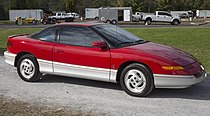
1992 Saturn SC (pre-facelift)
-

1995-1996 Saturn SC2
-

1995-1996 Saturn SC1
2nd generation [edit]
| Second generation | |
|---|---|
 | |
| Overview | |
| Also called | Saturn SL1 Saturn SL2 Saturn SW1 Saturn SW2 Saturn SC1 Saturn SC2 |
| Production | 1996–1999 SL 1996–1999 SW 1997–1999 SC |
| Model years | 1996-1999 |
| Torso and chassis | |
| Trunk style | 2-door coupe (1997–1998) iii-door coupe (1999-2002) four-door sedan 5-door station wagon |
| Powertrain | |
| Engine |
|
| Transmission | 4-speed Saturn MP6 automated 4-speed Saturn MP7 automatic 5-speed Saturn MP2 manual v-speed Saturn MP3 manual |
| Dimensions | |
| Wheelbase | 102.4 in (two,601 mm) |
| Length | 1996–99 SW & 1996–97 SL: 176.8 in (4,491 mm) 1998–99 SL: 176.9 in (4,493 mm) |
| Width | 1996–99 SW: 66.7 in (1,694 mm) 1997–2000 SC: 67.three in (i,709 mm) 1996–99 SL: 66.vii in (1,694 mm) |
| Summit | 1996–99 SW & SL: 54.5 in (1,384 mm) |
2nd generation SL and SW [edit]
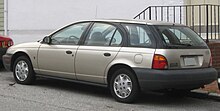
The 2nd generation SL sedans and SW station wagons were fabricated from 1996 to 1999. They had both featured a completely redesigned exterior. The interior was mostly the same every bit on the offset generation vehicles, while mechanically they went largely untouched. The redesigned 2nd generation South-series went on sale in 1995 for the 1996 model year.
A few minor changes were made for the 1998 model year S-serial vehicles. Due to multiple complaints about the dissonance coming from the vehicle'southward trip odometer that had been in all of the Saturn S-series since 1995, had replaced with a new blazon of trip odometer in an effort to correct the trouble. For the 1998 model twelvemonth, a new cluster with a digital trip odometer had been introduced. Rear disc-brakes were no longer available equally an option on the S series due to high costs for them as well as very piffling comeback in braking performance over the conventional rear drum-brakes setup.
Beginning with all of the Saturn S-series vehicles that were made in belatedly 1999 (sometimes referred to as 1999.5 models) had received improvements to both the SOHC and the DOHC engines in the S series. These changes included revised pistons, new connecting rods, and new crankshaft counterweights in the engine likewise. The Twin Cam cylinder head had now featured a new roller-rocker setup with hydraulic tappets and roller cams replacing the conventional saucepan lifter setup of the previous engine in the S series.
Also introduced for the 1999 model year S-serial vehicles that were sold in California was a different blazon of exhaust manifold that housed an upstream catalytic converter (this converter had heated up much faster than the conventional unit, and it had also decreased frazzle emissions faster as well), and information technology besides had provisions for an air-injection reaction organization (This had injected fresh air into the exhaust to reduce hydrocarbons during the startup of the vehicle, equally it would help the oxygen sensors and catalytic converters accomplish their operating temperatures faster). These vehicles were fabricated to run across the all-new CARB ULEV standards for the 1999 model twelvemonth.

Second generation SC [edit]

The second generation SC coupes were made from 1997 until 2002. The 2d generation SC coupes had besides moved to the longer wheelbase that the SL sedans and the SW station wagons had used, resulting in an equal wheelbase length across all Southward-series models. The redesign had resulted in a more curved wait for the SC coupes, which gave a slight increase in the vehicle's interior room/infinite, likewise equally a completely redesigned outside of the vehicle itself. For the 1999 model year, a front-opening clamshell door was added to the commuter's side of the vehicle. Even though this door on the driver's side of the vehicle had allowed easier access into the vehicle'south rear seat, the driver's seat in the vehicle was too able to slide forward to allow easy access to the vehicle'south rear seat as well. Equally a clamshell door, the rear driver'due south side door could not open unless the front door was open, considering the door handle was on the within of the door itself. Like the offset generation SC coupes, the SC1 model lacked a rear sway bar.
3rd generation [edit]
| Third generation | |
|---|---|
 | |
| Overview | |
| Also called | Saturn SL1 Saturn SL2 Saturn SW1 Saturn SW2 Saturn SC1 Saturn SC2 |
| Production | 2000-2002 SL 2000-2001 SW 2000-2002 SC |
| Model years | 2000-2002 |
| Body and chassis | |
| Body fashion | 3-door coupe 4-door sedan 5-door station wagon |
| Powertrain | |
| Engine |
|
| Transmission | 4-speed Saturn MP6 automatic 4-speed Saturn MP7 automatic 5-speed Saturn MP2 manual 5-speed Saturn MP3 manual |
| Dimensions | |
| Wheelbase | 102.4 in (ii,601 mm) |
| Length | 2000–02 SL & SW: 178.1 in (four,524 mm) 2001–02 SC: 180.five in (iv,585 mm) |
| Width | 2000–01 SW: 66.4 in (ane,687 mm) 2001–02 SC: 68.2 in (1,732 mm) 2000–02 SL: 66.4 in (1,687 mm) |
| Height | 2000–01 SW: 55.6 in (1,412 mm) 2000–02 SL: 55 in (1,397 mm) 2001–02 SC: 53 in (1,346 mm) |
Third generation SL and SW [edit]
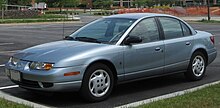
In 1999 for the 2000 model twelvemonth, the Saturn S-series had been redesigned for the last time before being discontinued in 2002. This resulted in the third generation Saturn S-serial.
The exterior of the Saturn SL sedans received new torso panels from the belt-line down. The rear cease of the SL sedans received a redesigned applique on the torso, and the headlights of the SL sedans had received orange turn point indicators.
The interior of all the Saturn S-series models received a completely redesigned dashboard, centre console, and steering bike, but the rest of the interiors were mostly unchanged. The SL2, SW2, and SC2 got the storage compartment with a sliding armrest in the center console as standard, whereas the SL1, SW1, and SC1 did non.[vi]
Similar the 1999 model yr SL sedans and the 1999 model year SW station wagons that were made in late in 1999, the 2000 model year SL sedans and the 2000 model twelvemonth SW station wagons had also included a digital trip odometer, which did not cause any issues like the analog trip odometers that were used in the 1991-early 1999 model year South-series vehicles.
The third generation Saturn S-series was also the first Saturn to use the torso control module (BCM), and the powertrain command module (PCM) systems in tandem with each other. In the 3rd generation Saturn S-series models, the PCM system was used strictly for the vehicle's manual and engine, whereas the BCM system was used strictly for the vehicle'southward interior functions such as the digital trip odometer and speedometer.
Beginning with the 2001 model year, side curtain airbags became available as an optional characteristic. The optional side curtain airbags were only available on the 2001 to 2002 model Saturn SL1 and SL2 sedans.

2000-2002 Saturn SL1 Rear
Third generation SC [edit]
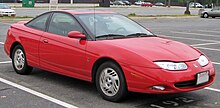
The third generation of Saturn SC connected to be available in SC1 and SC2 models. While retaining the previous generation's bodywork, it was facelifted with redesigned fascias front and rear, as well as new headlamps and tail lamps. The front fenders and door panels were also changed, continuing the character line all the manner down to the fog lite beneath the front bumper.[7] A PCM and BCM were added.[ clarification needed ] A new GT trim package had become available for the Saturn SC coupes for the 2001 model year, along with the pick of American Racing Wheels that was simply available on the GT version of the Saturn SC coupes. A rear spoiler on the vehicle's rear trunk lid was also made available for the 2001 to 2002 model year Saturn SC GT coupes.
Special edition Saturns [edit]
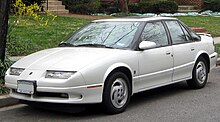
1994 SL2 Homecoming Edition
A special Homecoming edition of the SL2 was released for 1994. It had special Pearl White paint (a "silver-tint" pearl, shared with Cadillac models of this year), black Saturn emblems, spoiler, fifteen in (381 mm) "teardrop" wheels, anti-lock four-bike disc brakes, grey leather/cloth interior, rear headrests, fog lamps, and power locks and windows. Options included a sunroof, CD player, and the 4-speed automatic with traction command.
In 1998 and 1999, prospective buyers of a red or white SC2 had the choice of purchasing the "Black Top Coupe Package" for $225.00 (US). The models were referred to every bit the "Ruby-red Hot Coupe" or "White Hot Coupe", based on the exterior color. The package came with a black roof panel, blackness outside rearview mirrors, black emblems, white face gauges and black accented teardrop wheels. These are extremely rare.
In 1999, a second Homecoming Edition was produced in a special "Mint Color" with tan leather interior, special off-white gauge faceplates, and black Saturn badges to commemorate the second "Homecoming" visit to the Leap Hill, Tennessee manufacturing facility. The 1999 Homecoming Edition as well had the aforementioned features offered as the 1994 Homecoming Edition.
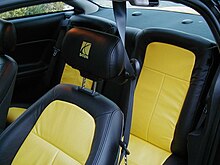
The interior of a Saturn Limited Edition SC2.
In 2001, a special yellow SC2 coupé model was also built. The model was officially named "Limited Edition", just soon became known as the "Bumblebee Edition". 99 were produced, each with a certificate of actuality. The "Bumblebee Edition" included embroidered headrests, blackness leather interior with yellow leather inserts on the seats and door panels, black roof and mirrors, number designation inside the fuel filler door, and a document of authenticity. These are not to exist dislocated with the regular outcome Yellow Sport Coupe.
For the 2001 model year merely, a special edition of the Saturn SL2 sedan that was chosen the Saturn SL2 tenth Anniversary Edition (also known as the Silvery Anniversary Edition) was made bachelor. The Saturn SL2 10th Anniversary Edition had included several upscale features that were not available on any other Saturn South-series vehicles like power windows, leather interior, standard side pall airbags, and several other upscale features. The Saturn SL2 10th Anniversary Edition too had "Saturn tenth Anniversary" stitched onto the front seat adjustable leather headrests. The Saturn SL2 10th Ceremony Edition had too featured a rear spoiler on the vehicle's rear trunk lid.
| 1994 Homecoming Edition | 3,500 |
| 1998 White Hot Coupe | 213 |
| 1998 Red Hot Coupe | 657 |
| 1999 White Hot Coupe | 285 |
| 1999 Red Hot Coupe | 284 |
| 1999 Homecoming Edition | iv,000 |
| 2001 Express Edition SC2 | 99 |
| 2001 10th Ceremony Edition | 1,000 |
| 2001 Bright Cherry | 664 |
Right-manus drive [edit]
In addition to the above-mentioned "Special Edition" Saturns; there was also the 1999–2001 Saturn SWP "Postal" station wagon that were produced (450 in 1999), intended to be marketed to rural route mail service carriers. These station wagons were right-hand-drive vehicles.
In that location were too a limited number of Saturns that were exported to Japan as right-hand-drive vehicles circa between 1997 and 2000 (during the lifetime of the 2nd-generation model). Aside from having the steering wheel on the other side, Japanese marketplace Saturns were also fitted with slightly unlike light units. The rear lamps had amber turn signals and the front end indicators were mounted closer to the corners rather than inboard. The SL and SW'due south engine displacement and dimensions were within the Japanese regime'due south dimension regulations and engine tax brackets (as only one.ix-liter engines were offered for the 2nd-generation models), although the SC did not see the dimension regulations and would have been subjected to annual taxes.
Saturn faced a hard time in Nippon, where it played direct into the strengths of the Japanese manufacturers, comparison unfavorably with improve-priced and more competent Japanese compact cars.[8] The interior, especially, received criticism.[9] A mere 602 units were sold in Saturn's offset yr in Nippon (Apr to December 1997).[10]
Another problem was that Japanese auto dealers have always excelled at customer service; this meant that Saturn's main sales argument in the United States was meaningless in the Japanese market.[xi] The introduction of Saturn was too ill-timed, as the economic system was in the midst of a recession due to the effects of the 1980s "bubble economy". As the Japanese had less money to spend on "luxury goods", as imported products are regarded, Saturn constitute very few buyers.
Theft [edit]
The 1995 Saturn SL was the nearly stolen vehicle in 2003, while the 1994 SL took third place in CCC Data Services'due south 2003 most stolen vehicle report.[12] Co-ordinate to the Lynnwood, Washington police department, when use of the key wears on the door and ignition mechanisms, a filed bare key can exist used to open the door and start the engine.[ citation needed ]
Racing [edit]
Saturn SC's competed in the SCCA World Challenge in the 1990s, winning several races from 1995 to 1997.[xiii] [14] [15] Several Southward-series cars have been used as rally race cars. Southward-Series cars are also popular in dirt oval racing and autocross.[ citation needed ]
Safety [edit]
Insurance Institute for Highway Rubber (IIHS) [edit]
| Moderate overlap frontal get-go | Acceptable |
| Small-scale overlap frontal start | Non Tested |
| Side impact | Non Tested |
| Roof force | Not Tested |
NHTSA [edit]
| Year | Frontal Driver | Frontal Passenger | Side Driver | Side Passenger | 4x2 Rollover |
|---|---|---|---|---|---|
| 1991 | | | Not Rated | Not Rated | Not Rated |
| 1992 | | | Not Rated | Not Rated | Non Rated |
| 1993 | | | Non Rated | Non Rated | Non Rated |
| 1994 | | | Not Rated | Not Rated | Not Rated |
| 1995 | | | Not Rated | Not Rated | Not Rated |
| 1996 | | | Not Rated | Not Rated | Not Rated |
| 1997 | | | | | Not Rated |
| 1998 | | | | | Not Rated |
| 1999 | | | | | Not Rated |
| 2000 | | | | | Not Rated |
| 2001 | | | | | |
| 2002 | | | | | |
Production numbers [edit]
Listed below is a rough judge on the numbers of Due south series produced from 1990 to 2002.[29]
| Year | Coupe | Sedan | Wagon | Total | ||||||||
|---|---|---|---|---|---|---|---|---|---|---|---|---|
| SC | SC1 | SC2 | Total | SL | SL1 | SL2 | Total | SW1 | SW2 | Full | ||
| 1991 | ~x,000 | - | - | ~20,000 | ~38,629 | - | - | - | ~48,629 | |||
| 1992 | - | - | - | - | - | 169,959 | ||||||
| 1993 | - | 244,621 | ||||||||||
| 1994 | - | 267,518 | ||||||||||
| 1995 | - | 62,434 | 221,102 | xix,452 | 302,988 | |||||||
| 1996 | - | 294,198 | ||||||||||
| 1997 | - | 70,711 | 213,182 | 31,099 | 314,992 | |||||||
| 1998 | - | 38,591 | 160,759 | xx,415 | 219,765 | |||||||
| 1999 | - | 52,965 | 203,578 | 19,090 | 275,633 | |||||||
| 2000 | - | 8,517 | 8,724 | 17,241 | 68,907 | 142,992 | 9,633 | 169,866 | ||||
| 2001 | - | 23,584 | 17,414 | twoscore,998 | 73,428 | iii,416 | 117,842 | |||||
| 2002 | - | - | - | - | ||||||||
References [edit]
- ^ A model proper noun with a "ane" marked an SOHC/base trim variant while "2" signified a DOHC/upgraded trim choice
- ^ Electronic Variable Orifice, a power steering pump modification that allows for proportional steering
- ^ Krebs, Michelle (1999-02-07). "Saturn SC2; Finding a Jackpot Behind Door No. iii". New York Times . Retrieved 2012-07-30 .
- ^ "Compare Old and New EPA MPG Estimates: 1997 Saturn SL". U.s.a. Environmental Protection Agency. Retrieved January 27, 2010.
- ^ http://oldcarbrochures.org/index.php/New-Brochures---May/1991-Saturn-Full-Line-Brochure/1991-Saturn-Full-Line-24-25 [ dead link ]
- ^ "2001 Saturn S-Series Prestige-17". oldcarbrochures.org. Archived from the original on 2018-11-06.
- ^ unknown. "2002 Saturn SC". cars.com . Retrieved seven Apr 2014.
- ^ Latham, Scott (1998-05-13), Grinding Gears: The Japanese Auto Dealer Network and American Trade Complaints (PDF), Chester Springs, PA: Scott Latham Associates, p. 60
- ^ Latham, p. 64
- ^ Latham, p. 59
- ^ Latham, p. 62
- ^ "1995 Saturn SL Tops Most Stolen Vehicle List". saturnfans.com/ . Retrieved 2008-04-03 .
- ^ "1995 World Challenge : Round one" (PDF). Scca.cdn.racersites.com. Archived from the original (PDF) on 24 May 2013. Retrieved 23 Feb 2015.
- ^ "1996 Globe Challenge" (PDF). Scca.cdn.racersites.com. Archived from the original (PDF) on 24 May 2013. Retrieved 23 February 2015.
- ^ "SCCA Pro Racing Results : 1997 World Challenge Touring 1 Grade" (PDF). Scca.cdn.racersites.com. Archived from the original (PDF) on 2013-05-24. Retrieved 2013-10-thirteen .
- ^ "IIHS-HLDI: Saturn SL". Iihs.org. Retrieved 2013-03-22 .
- ^ "1991 Saturn SL 4-DR. | Safercar – NHTSA". Safercar.gov. Retrieved 2013-03-22 .
- ^ "1992 Saturn SL 4-DR. | Safercar – NHTSA". Safercar.gov. Retrieved 2013-03-22 .
- ^ "1993 Saturn SL 4-DR. | Safercar – NHTSA". Safercar.gov. Retrieved 2013-03-22 .
- ^ "1994 Saturn SL 4-DR. | Safercar – NHTSA". Safercar.gov. Retrieved 2013-03-22 .
- ^ "1995 Saturn SL four-DR. | Safercar – NHTSA". Safercar.gov. Retrieved 2013-03-22 .
- ^ "1996 Saturn SL 4-DR. | Safercar – NHTSA". Safercar.gov. Retrieved 2013-03-22 .
- ^ "1997 Saturn SL 4-DR. | Safercar – NHTSA". Safercar.gov. Retrieved 2013-03-22 .
- ^ "1998 Saturn SL 4-DR. | Safercar – NHTSA". Safercar.gov. Retrieved 2013-03-22 .
- ^ "1999 Saturn SL four-DR. | Safercar – NHTSA". Safercar.gov. Retrieved 2013-03-22 .
- ^ "2000 Saturn SL four-DR. | Safercar – NHTSA". Safercar.gov. Retrieved 2013-03-22 .
- ^ "2001 Saturn SL 4-DR. | Safercar – NHTSA". Safercar.gov. Retrieved 2013-03-22 .
- ^ "2002 Saturn SL four-DR. | Safercar – NHTSA". Safercar.gov. Retrieved 2013-03-22 .
- ^ Auto Editors of Consumer Guide (2002). The Encyclopedia of American Cars. Publications International.
How Many 2002 Saturn Sl1 Are Registered Today,
Source: https://en.wikipedia.org/wiki/Saturn_S_series
Posted by: harrisanningues.blogspot.com


0 Response to "How Many 2002 Saturn Sl1 Are Registered Today"
Post a Comment